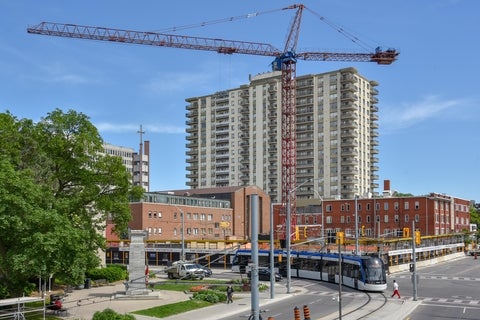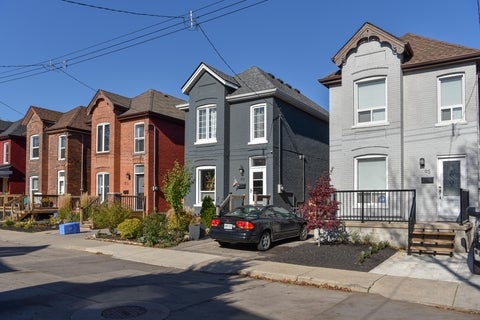Report: Experiencing urban change along Hamilton’s LRT corridor: Resident experiences prior to construction
By Rebecca Mayers, Brian Doucet, Nicole Rallis and Caleb Babin
Read the full report here:
Report Summary
Hamilton is about to embark on the construction of a new 14-kilometre light rail transit (LRT) line between McMaster University and the Eastgate Square shopping centre. In between, it will run through many different neighbourhoods, including some of the city’s poorest. There are already signs that change is taking place. The aim of this report is to better understand what kinds of urban changes are experienced by residents living along the LRT corridor even before construction begins. We want to contribute to debates in the 4Ps: the planning, policy, political, and public spheres.
To do this, we engaged with residents to understand their observations and experiences of change. This kind of research helps us to see patterns, processes, and experiences at both a fine-grained and city-wide level. Much of this knowledge either does not show up in statistics, or is only evident in data such as the Canadian census after events have already happened.
Our research is based on the following:
- Experiences of 106 residents living within 1 km of the planned LRT route
- 68% of participants are homeowners; 32% are renters
- 18% live in Ward 1; 15.1% in Ward 2; 40.5% in Ward 3; 23.5% in Ward 4; 1.9% in Ward 5; 1% non-disclosed
- Detailed transcriptions and notes were thematically analyzed into findings and recommendations


Major Findings
1. Housing Insecurity: “Everyone is just one bad story away from homelessness.”
The most common story we heard was that living along the planned LRT corridor is increasingly unaffordable for many of the existing low- and middle-income residents. Renters in particular are concerned about rising rents, housing insecurity, and being evicted if their landlords want to renovate their apartments. Some of the homeowners interviewed had their homes passed down to them by family members. Like renters, they expressed concerns about increasing housing costs and their inability to afford their neighbourhood if they had to buy in the existing market. Many properties along the route are currently vacant. Some of these vacant properties are those that have been purchased by Metrolinx. According to the local knowledge of our participants, many of these properties housed low-income residents before the buildings were acquired and demolished. As there were no new affordable units added to the supply when these buildings were demolished, this is one of the factors already contributing to an erosion of affordable housing along the proposed route.
2. LRT and Community Engagement: “There is a real distrust in the establishment, so we need to build trust, not just check off a box.”
Participants overwhelmingly felt ignored and confused in the community engagement process for the LRT. The majority of participants thought there could be more transparency, and continued to question many aspects of the project, including: property acquisitions, where the stations will be and why, cost of travel, changes to the Hamilton Street Railway (HSR), intersection adaptation, construction impact on existing infrastructure, and parking and traffic flow. While many forms of communication have been used by the city, HSR, and Metrolinx, it was clear that much of this information was not reaching the residents we spoke with.
3. Future Challenges: “There will be a lot of growing pains”; “Where will we go?”
Residents stated that they are already experiencing growing pains associated with development and intensification along the LRT corridor. Some of the growing pains mentioned were a result of changes to the built environment, including approaches to transportation, travel patterns, and mode choice. Participants also expressed concerns about affordable housing for low- and middle-income residents along the corridor. The City of Hamilton will need to consider policies to protect renters from displacement, renovictions, and unfair/illegal practices by landlords.
Recommendations
- All levels of government, including the City of Hamilton, will need to take a proactive approach to shape housing development along the LRT corridor to prevent further displacement. This approach includes: using publicly owned land to build affordable housing, stronger rules to protect tenants from displacement, and better enforcement of the already-existing rules to ensure tenants’ rights.
- The City of Hamilton should take a proactive approach to use its own land to construct new non-market, affordable housing, as well as working to acquire more sites within the LRT corridor that can be used for housing that the market is unwilling or unable to build.
- Land that Metrolinx has acquired for the construction of the LRT should be used to build genuinely affordable housing in conjunction with the City or non-profits once it is no longer needed for the LRT project.
- Metrolinx and the City of Hamilton need to better inform residents about changes, disruptions, plans, and construction at all stages of the LRT. A lack of clear communication about the development and operation of the LRT leads to confusion, misunderstanding, and mistrust.
- Continued research is needed to better understand the lived experiences and local knowledge that residents have about changes taking place. We caution against relying primarily on analysis from the census to monitor change along Hamilton’s LRT corridor. Instead, we recommend regular and systematic research that engages meaningfully and respectfully with residents living along the proposed route, including working with researchers, non-profits, and community groups to engage with segments of the population that often feel excluded from mainstream modes of planning communication.
This research is funded in part by the Hamilton Community Foundation, Social Sciences and Humanities Research Council, and the Canada Research Chairs program.


